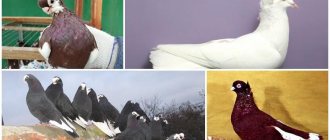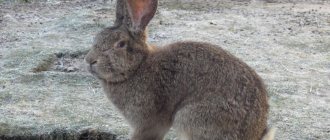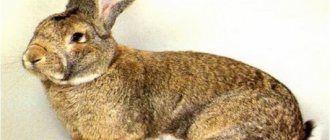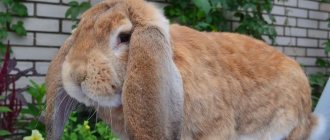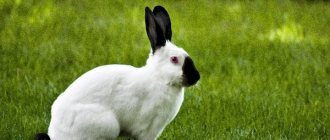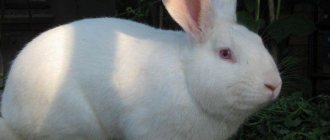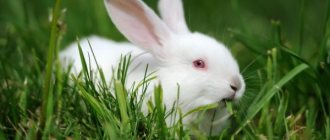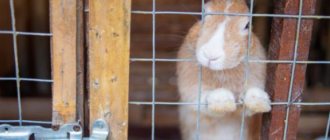The history of the origin of rabbit breeding dates back to the 3rd century BC. e., thanks to the Romans, who discovered wild rabbits on the Iberian Peninsula. At that time, animals were able to cover the meat needs of Roman soldiers. The fame of the edible rodents quickly spread. Animals began to be bred in the Mediterranean countries, and later throughout the world.
In Russia, rabbits became known in the 11th century, when they were brought into households to obtain warm skins. It was only at the beginning of the 19th century that meat breeds of long-eared animals were brought from Europe and began to be raised for meat. Since that time, rabbits have gone through more than one breeding and selection process, and farmers have managed to obtain animals with excellent performance. But they have become not only a valuable source of meat products and fur. People began to have rabbits as good-natured and cute pets.
Flanders is the most common breed of large rabbits
The Flanders or Belgian Giant is perhaps the most famous breed of large rabbit. The first mentions of these giants appeared 500 years ago. They began their history in Belgium in the province of Flanders, hence the two names - Belgian giant and Flanders. These rabbits belong to the meat and wool breed.
Flanders
The maximum weight of this breed is reached by 1 year and is 8-10 kg. The body length of giants reaches 90 cm. If a rabbit is less than 70 cm, then this is considered a breed defect. Its front legs are short, and its hind legs are quite long and large. They have a heavy and large head with long ears, the length of which reaches 19 cm. Flanders have a strong skeleton, a straight and wide spine. The tail is long, stiff and slightly carried upward.
The breed's fur is quite thick and silky. The length of the hair reaches 3-4 cm. The coat can have the following color:
- gray-brown;
- blue;
- white;
- coffee;
- grey;
- white;
- kangaroo;
- black.
Red Flanders
Flandre is calm by temperament. He will not jump and run around like small breeds. He prefers to lie quietly and watch. Flandre is quite friendly and calm, he treats people well. He easily allows himself to be petted and played with. This breed is a good alternative to affectionate dogs, such as Labradors. They are truly gentle giants that get along well with both people and animals.
Angora rabbit
In addition to meat breeds of rabbits, animals with thick, long or short fur, bred for their fluff or skins, are popular. Angora rabbits are classified as down rabbits. The animals have thick, thin hair from 15 to 25 cm, and this record length is maintained almost throughout the body, so long tufts of hair are often found between the toes of the paws; there are also tassels on large rabbit ears. The color of rabbits can vary. Due to the abundance of honey, the animal seems large; in fact, the Angora rabbit rarely weighs more than 3.5 kg, which it reaches at seven months of age.
The first information about the unusual breed reached Europeans at the beginning of the eighteenth century. The homeland of long-haired animals is Turkey, from where strange rabbits came first to the Old World, and then to America. If initially the Angora rabbits shown in the photograph were a rare pet, today their fluff is widely used for the production of warm yarn, fabrics from it and ready-made clothing.
Continental Giant – champion breed
Rabbits of the Continental Giant or Conti breed are known for their championship makings. The two largest rabbits registered in the Guinness Book of Records belong to this breed. This is one of the most ancient breeds, which is still popular today.
Conti
The average weight of these giants at their peak is 16 kg, but with proper care they can weigh more than 20 kg. The body length is at least 65 cm. This breed has large ears, the length of which can reach 20 cm. The rodent has a rather dense and powerful bone structure. Conti's fur is dense, thick rollback, and silky to the touch. The villi reach a length of 4 cm. There are 7 fur colors:
- black – plain black fur, the rabbit’s eyes are black or light brown;
- light steel - the hairs are gray on top, sandy in the middle, gray-blue closer to the body;
- dark steel – dark gray color, lighter closer to the skin, brown eye color;
- Agouti is the most common color of this breed. The fur is chestnut, orange in the middle, and the undercoat is dark gray. There is a black edging on the ears and the underside of the tail, a white belly;
- red agouti – chestnut-red coat, black ticking, dirty blue undercoat. The rabbit's tail and belly are cream-colored;
- opal – the coat is pale blue at the top, creamy in the middle, the undercoat is dark. The ears have a dark blue edging. The eyes, tail and belly are light beige;
- Fawn is a color with shades of red, the belly is white or beige, and the undercoat is light.
Conties get along well with pets
These rabbits live up to nine years. Average life expectancy is 4-5 years. These giants have an excellent character; they are quite affectionate and friendly. In addition, they are quite smart and calm. You can play with them, “squeeze” or stroke them without any problems. These rabbits are often kept as pets. They can easily be taught the simplest commands. But like all rabbits, they are quite timid, so you should not expose Conti to stress.
How to train a rabbit
Rabbits are very intelligent and sociable, so they can be trained quite easily. If you want to have a good relationship with your rabbit and train it properly, then you should immediately read this article and start training.
Meat breeds
Animal meat is very tasty, healthy and dietary. The average weight of rabbits can exceed 5 kg, which is why they are popular for fur and fluff. For farmers, this is an excellent source of profit - the product is sold quickly and at a good price.
It is important to choose a variety suitable for certain purposes - meat, meat skin, skin. More than 50 breeds of rabbits have been bred, each with its own characteristics. Common names are ram, giant, flander.
Almost all rabbits are used for food purposes, except for decorative species. Special breeds are bred for profit from the sale of meat products.
When choosing rabbits to obtain the maximum amount of meat products, pay attention to the following:
- high quality of the product - it is tasty, healthy for everyone, but in certain varieties this product is the most delicate, which allows it to be sold at a high price;
- weight gain - the faster the animals gain their maximum, the less labor costs are spent on them and the sooner the product is sold and a profit is made;
- size of the animal - some species are very large, reaching a weight of more than 7 kg, from them they get a lot of meat and good skins;
- precocity – rabbits that breed quickly, produce offspring, and provide the breeder with significant profits;
- disease resistance - various infections, fungi can quickly destroy up to 80% of adults, up to 9-5% of young animals. Some varieties have stronger immunity - the likelihood of an epidemic among them is much lower;
- adaptability to the area - not all animals are able to survive and give abundant offspring if they are forced to live in a region with a climate different from where they were born.
Main types of animals
Classic varieties are not always large. They live with breeders for a very short time: those left for breeding - within 3.5 years, slaughtered for meat - 3-8 months. Their main advantage is a solid slaughter yield and early maturity.
These include:
- New Zealand white, red;
- European, Poltava silver;
- Californian species.
They have less weight than meat-skinned ones, but gain maximum weight by 3-6 months of their life, which makes their breeding profitable. The quality of the carcasses is also always at its best. The skins are suitable for sale, but the volume is low, the area is small, and you won’t be able to get a lot of money for them.
The California rabbit was bred from the New Zealand white rabbit and has many positive qualities, which is why it is often bred by professionals from Europe and America. He quickly gains weight up to 5 kg. The animal is ready for slaughter after 90-100 days, and is capable of breeding from 5-5.5 months. There are 8-10 cubs in one litter; due to its small size, the breed is kept in relatively cramped rabbitries. The growth rate of the California rabbit is amazing - at 8 weeks it weighs on average 2.5 kg.
Due to its light skeleton and excellent carcass properties, from 3 months of life, a rabbit has a slaughter yield comparable to an adult animal. The animal is unpretentious, resistant to many diseases, and the demand for rabbits of this species is very high.
New Zealand White - bred at the beginning of the last century from New Zealand Red. They are almost identical in constitution, fertility, and early maturity. The second variety is more whimsical and has bright red fur. White rabbits weigh 4.5-5.5 kg, grow quickly, gain weight, have delicious dietary meat, and high-quality white skin.
At 2.5-3 months it weighs around 3 kg, many are already slaughtered at this time. New Zealanders are prolific - there are at least 8 cubs in one litter. The breed easily adapts to any living conditions; even in cold areas they are bred in enclosures with mesh and lattice floors, which reduces cleaning time. The variety has good health and, if properly vaccinated, does not get sick at all.
Risen - a giant from Germany
German Riesen is the work of breeders from Germany. The breed was developed from the Belgian giant in 1937. Translated from German, “Riesen” means giant. This breed belongs to the meat and wool category, like most other giant rabbits.
Rizen's meat is very juicy. It is considered one of the most delicious among giant rabbits.
Risen
The weight of an adult Risen is 6-10 kg. However, some rabbits reached a weight of 14 kg. Rabbits have well-developed muscles and a massive build. They have fairly large, fleshy ears located on a wide head; the length of the ears reaches 20 cm. The legs are massive and strong. The fur is thick and dense. The length of the pile reaches 4 cm. There are various colors: sand, blue, black, dark gray and others.
Risen - a giant from Germany
Rizen's character is excellent. They are good-natured and fearless. They can also be kept as pets. These rabbits are not particularly popular on the farm. They grow quite slowly and require a lot of space to keep them.
Gray giant
The Gray Giant breed was bred in Ukraine in the Poltava region. Breeders from the Petrovsky animal farm crossed Flander with outbred rabbits. From Flander, the Gray Giant took large sizes and colors. And other rabbits have adaptation to different living conditions.
Gray giants have large bones and bodies. The body length reaches 66 cm, and the weight can be up to 7 kg. The legs are long and straight. The ears are erect and long, slightly rounded at the ends. The coat is dense and dense.
Gray giant
A special feature of the Gray Giant is its large area of skin. Sometimes its area can reach 3 m2.
The fur of this breed can be of the following colors:
- grey;
- black;
- dark grey.
The undoubted advantage is the unpretentiousness of the Gray Giant. It is suitable for growing in cramped conditions and does not require undue attention. In addition, breeders note the fertility of females.
Rabbit Rex
The ancient German breed of Rex rabbits is distinguished by its extremely thick short fur, giving the impression of plush or sheared high-quality sheepskin. In the USSR, the history of the breed began about a century ago. Rex rabbits, despite the ban from the German authorities, were secretly taken out of the country, were raised and gave birth to offspring in the USSR.
Famous for their soft, velvety fur, rabbits also produce excellent meat. An adult grows up to 4–5 kg. And with a fairly light, thin skeleton, the yield of lean dietary meat is significant.
The breed characteristics of Rex rabbits include a large, elongated body, small rounded ears, and short, downward-curved mustaches. Today, there are many solid and spotted colors that diversify the fur skins obtained from rabbits.
White giant
The ancestor of the White Giant is the Belgian Giant. Among the Belgians, only albinos with white fur were selected. They were crossed with chinchillas and the Gray Giant breed. The result was a snow-white albino rabbit with excellent weight characteristics.
White giant
It is very easy to distinguish the White Giant from other breeds - these rabbits have a snow-white coat and red eyes. The body is strong and moderately long (about 60 cm), weight is 4-6 kg. The paws are thin but strong. The ears are erect and of medium length. The White Giant's fur is the pride of this breed. The coat is thick and dense. The skins of rabbits of this breed are highly valued among fur manufacturers.
Video - Review of the White Giant breed
What breeds of rabbits are bred in the Ryazan region
Meat, decorative, down and fur rabbits - animals of various types are bred in the Ryazan region. The largest livestock farms, like the Berkeevo peasant farm, focus on the following breeds: White and Gray giant, Butterfly, Black-brown, Silver and Californian rabbit, Soviet chinchilla. The Ryazan region is famous for its products due to the strict selection and professionalism of breeders.
Rabbits are useful and productive animals. With the right choice of breed, you can open a profitable business or simply provide your family with soft fur and delicious meat. They can also be bred as decorative animals; in this case, profit can be made for the valuable offspring of purebred individuals.
Ram - giant lop-eared rabbit
The French ram is the only decorative rabbit that is classified as a giant. The breed dates back to 1850. It was then that the first mention of the breeder Condeniere from France appeared. He was not a professional and was engaged in book binding. However, this did not stop him from developing such an interesting breed. The basis for the hybrid was an English ram, which was crossed with the Norman and Rouen breeds. Condeniere's goal was to create a commercial rather than an ornamental breed.
French ram
The weight of a French ram is at least 5 kg. The body in the back is round and massive. The legs are meek but strong. The main feature, of course, are the ears. The French ram's are long and droopy. They hang down without curling and have no folds. The breed criterion is that the ears hang at least 4 cm below the chin.
A feature of French rams is age-related flabbiness. As they age, they develop a “skirt” of skin at the back of the body.
There are many colors of the French Ram. From white to black. The fur of these rabbits is of medium length, the hairs reach 3 cm.
The fur of French Rams is very pleasant and soft.
These rabbits are calmer in nature and are even suitable for keeping indoors. They get along well with people, including small children. Rams are playful, they will happily have fun with the simplest toys like a ball or a cardboard box. But it is worth remembering that they are quite mobile. Therefore, it is worth providing them with a place to play. If you are not ready to devote a lot of time to the French Ram, then it is better to make him a friend.
Rabbit butterfly
Russian rabbit breeders have been familiar with the butterfly rabbit with its original coloring, which gave the breed its name, for more than two hundred years. It was in our country that the best results were achieved during breeding work. Today, rabbits weigh not three kilograms, but almost twice as much as when they arrived from Britain. In addition, they are better adapted to being kept in local conditions.
If you look at the animal’s face, you will notice a large dark spot, shaped like a moth with outstretched wings. The breed of rabbits shown in the photograph owes its name to this spot. Other spots, already of arbitrary shape, can be seen on the body, around the eye sockets and on the ears. There is also a dark stripe along the spine. The claws and tail are light. The spots on a butterfly rabbit can be of different shades from black to cream.
How to keep giant rabbits?
Of course, giant rabbits will not be suitable for the typical living conditions for small rabbits. If you want to raise a champion, you will have to take care of both its habitat and feeding. Of course, each species has its own content characteristics. Below are some general guidelines.
Giant rabbit on the run
Where to place it?
The most common housing option for rabbits is cages. It is also suitable for giant breeds. Only the cells must be much larger than for small representatives of this species of animal. Average size – at least 0.6 sq.m. for one rabbit. But everything will depend on the size and weight of the particular animal. The best option would be to place the cages outdoors.
Prices for cages for rabbits
Rabbit cage
Giant rabbit in a cage
It is better to make the floors of the cage mesh or slatted. This will help in getting rid of droppings, which often cause diseases. Hay or straw is placed at the bottom; it is important to change the flooring regularly. If possible, it is worth organizing a pen for the giants, where they can walk peacefully.
Often, giant rabbits are kept directly in the house instead of pets.
Giant rabbit in the house
What is the best way to feed giant rabbits?
When it comes to food, giants are most often unpretentious. They feed on the same food as small representatives of the species. The only difference is the amount of food.
